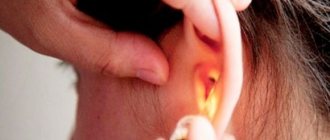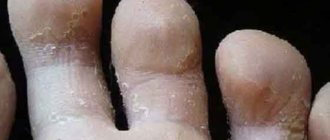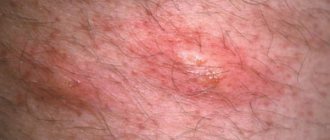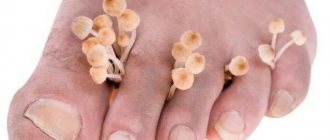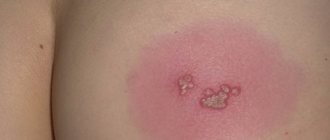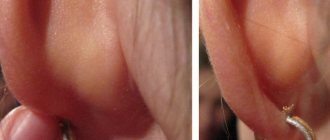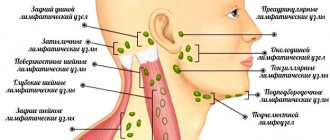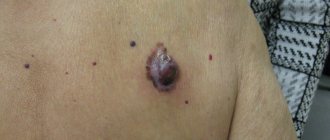What kind of fungus develops between the fingers?
Inflammation of the interdigital area of the skin of the hands is caused by dermatophyte fungi or yeast-like fungi of the genus Candida.
Microorganisms usually enter human skin for the following reasons:
- performing manicures with contaminated instruments;
- use of objects touched by the patient;
- touching contaminated surfaces in public places.
Once on the skin, fungal spores may not manifest themselves for a long time and begin to develop when favorable conditions occur:
- with weakened immunity;
- with hormonal imbalances in the body: pregnancy, menopause, adolescence;
- with increased sweating of the hands;
- with frequent contact with water and chemicals;
- under stress;
- for chronic diseases;
- disruptions in the functioning of the endocrine system.
Preventive measures
The best treatment for a disease is prevention. By following simple rules, you can reduce the risk of mycosis several times. First of all, it is necessary to maintain hand hygiene and use antibacterial soap for washing several times a day. Always use gloves when doing household work. Treat any abrasions and scratches with an antiseptic solution in a timely manner.
It is necessary to monitor your general health and take vitamins to boost your immunity. All personal hygiene instruments must be thoroughly disinfected . You should never wear someone else's gloves or use towels in public places. Linen should be washed at a temperature of 90° C. This is when the fungal spores die.
At the slightest suspicion of a fungus, you should immediately contact a dermatologist . Compliance with all the rules will guarantee that fungal infections will not arise or appear again.
Symptoms and stages of the disease
Characteristic symptoms of the disease:
- severe itching;
- peeling of the skin;
- cracks and erosion;
- feeling of skin tightness;
- thinning of the upper layer of the epidermis.
The disease progresses rapidly, going through 4 stages:
- Initially , the fungus affects the area between several fingers . Most often, the pathological process originates between the little finger and the ring finger. The skin becomes covered with small bubbles that burst and cracks form in their place. The skin becomes wet, red, and swollen.
- In the second stage, the skin begins to dry out , and this calms the patient. After some time, the skin begins to dry out and crack. The itching intensifies and a burning sensation appears. When infected with Candida fungus, the skin becomes covered with a white coating.
- The third stage is manifested by thickening and roughening of the skin . The surface acquires a bluish tint. Sometimes large blisters appear on the skin, which, after opening, turn into non-healing erosions.
- The fourth stage of mycosis causes the fungus to spread to the palm and fingers . Mycosis covers the entire hand. The skin begins to peel off, swell, and become covered with deep cracks. When a secondary infection penetrates into the wounds, they begin to fester and become covered with crusts.
Often, in an advanced stage, interdigital fungus begins to penetrate the nails. The nail plates change color, become deformed, and thicken.
Symptoms of mycosis
The two forms of the disease differ in their symptomatic manifestations. Treatment for interdigital fungus on the hands depends on the causative agent of the disease.
Dermatophyte fungi cause dermatophytosis. It can occur in acute or chronic form.
Main signs of dermatophytosis:
- begins with an inflammatory process;
- cracks and bubbles form between the fingers;
- the skin dries out and peels;
- ulcers appear that become wet and peel off;
- The lesions are surrounded by a white coating.
Infection with a fungus of the genus Candida is painful and itchy. Peelings are ring-shaped or moon-shaped. Inflammations are mealy in nature.
Interdigital candidiasis is most often found in certain populations :
- patients with diabetes mellitus;
- suffering from hyperthyroidism;
- aged people;
- people living in hot climates;
- people who are forced to work with aggressive substances.
Wounds between the fingers do not go away on their own. They will move from the acute stage to the chronic stage until they affect the skin of the palms and nails.
Diagnostics
Many patients consider themselves experts in fungal infection and diagnose themselves by comparing their own symptoms with photos on the Internet.
The result of incorrect identification of the type of fungus is treatment with the wrong drug.
Knowing what a fungus looks like is not enough to make an accurate diagnosis.
A reasonable solution is to consult a dermatologist at the first symptoms.
The doctor will order laboratory tests to determine the type of causative agent of the disease.
The most informative analysis is bacterial seeding of skin scrapings into a nutrient medium.
Additionally, a blood test is prescribed to identify concomitant inflammatory processes in the body.
IMPORTANT! A necessary element of the examination is differential diagnosis with diseases such as psoriasis, allergic dermatitis, eczema, and neurodermatitis. Treatment of these ailments requires a completely different approach, and the use of antifungal agents may aggravate the patient's condition.
Lichen
Such an unpleasant disease as lichen can spread to a person from a domestic or street animal, and even from touching the sand on which it was sitting. The disease appears in the form of pink spots with a red rim; they quickly increase in size and spread throughout the body. In this case, you cannot practice self-medication; you must consult a doctor who will prescribe medications in the form of ointments and cauterization with iodine.
Treatment
Fungus between the fingers requires complex treatment, external and systemic. The course of treatment is long - from several weeks to 12 months.
In addition to the use of medications, a special diet and careful skin hygiene are required.
During treatment, the patient is recommended to exclude sweets, flour, fatty foods, and alcohol from the diet.
The menu should consist of fermented milk products, vegetables, lean meat, and cereal porridges.
The skin of the hands is cleaned with antiseptic solutions: potassium permanganate, Furacillin, salicylic alcohol, Castellani liquid.
IMPORTANT! During antifungal therapy, moisturizing and nourishing creams are not used to lubricate the skin. They create a film on the hands, under which fungal spores actively multiply.
Medication
The main means of treatment are ointments, creams and solutions for external use. At the initial stages of development, microorganisms can be completely destroyed with these drugs.
The following drugs are most effective, according to reviews from patients and doctors:
- "Exoderil". Ointment with a broad spectrum of fungicidal action. Penetrates deeply into the layers of the epidermis, quickly relieves inflammation.
- "Lamisil." Cream and ointment that stops the development of fungal spores.
- “Zalain.” Sertaconazole-based ointment. Effective even at advanced stages of fungal development.
- “Candide.” Ointment based on clotrimazole, broad spectrum of action.
- “Nizoral.” Cream based on ketoconazole.
At advanced stages of the disease, in addition to local ones, oral medications are prescribed:
- “Ketoconazole”;
- “Itraconazole”;
- “Fluconazole”;
- “Orungal.”
ATTENTION! Infection of the body with a fungus is accompanied by weakened immunity and disruption of the intestinal microflora. An important component of fungal therapy is the restoration of healthy intestinal microflora by taking probiotics (“Acipol”, “Bifidumbacterin”, “Maxilak”) and maintaining immunity with vitamin complexes and immunostimulants (“Imudon”, “Bronchomunal”, “Likopid”, “IRS-19”) .
Physiotherapy
Physiotherapeutic procedures are an important component of antifungal therapy. The main goal of procedures in the treatment of interdigital fungus is to stimulate peripheral circulation.
For this purpose, the following procedures are used:
- diathermy;
- UHF therapy;
- amplipulse therapy;
- supravascular laser irradiation of blood.
Traditional methods
Remedies made according to folk recipes are quite effective in combating microorganisms in the initial stages of infection.
The following folk remedies help to cope with fungus between the fingers:
- Chicken egg ointment . Dip a raw chicken egg into 100 ml of vinegar essence and wait until it completely dissolves (about 7 days). Then add 200 grams of butter to the mixture. The resulting ointment is applied to the inflamed areas 2 times a day.
- Ointment based on a decoction of calendula , hop cones and burdock roots. To prepare, take 10 grams of calendula and 30 grams of crushed hop cones and burdock roots. The mixture is placed in a saucepan, filled with water and heated over low heat until thickened. Add an equal volume of Vaseline to the cooled mixture.
- Baths with chamomile infusion . 1 tablespoon of chamomile flowers is poured into 200 ml of boiling water and left until it cools completely. Then the broth is filtered and the hands are dipped into it.
- Garlic compress . Garlic pulp is mixed with an equal volume of olive oil, applied to the hands, and wrapped in a bandage and cling film. The compress is made at night, and in the morning the garlic mixture is washed off with a soda solution.
- Clay applications . Cosmetic clay is diluted with water and lubricated on inflammation. After 15 minutes, wash off with water and lemon juice.
- Onion-lemon lotion . The juice of the two products in equal volumes is mixed and lubricated on the skin. Wash off the product after 40 minutes.
Video recipe: Effective ointment for fungus on the legs and arms, 100% result
The author of the video assures that the recipe is completely reliable, but like all folk methods, this method also requires approval from a doctor
IMPORTANT! Folk remedies cannot cure fungus at an advanced stage, so they are used as an addition to medications.
Causes of fungal infection
There are a huge number of reasons why fungus appears on the hands between the fingers.
Infection can occur:
- during direct bodily contact between a healthy person and a sick person (handshake);
- upon contact with things that a sick person had previously been in contact with;
- by transferring the infection from one infected area of the body to another (for example, from the toes to the toes);
- while swimming in the pool or visiting the bathhouse.
The likelihood of infection increases if there are injuries on the hands - wounds, abrasions, scratches.
However, infection with fungi does not mean illness. Often an infected person does not get sick or experience any unpleasant symptoms of the disease. Such people are carriers of infection.
The pathology begins to progress with a decrease in immunity. This usually happens in the following cases:
- in the presence of endocrine disruptions, serious pathologies of internal organs;
- during age-related changes;
- with insufficient blood circulation;
- if a person has bad habits, eats incorrectly;
- if a person is often exposed to stressful situations.
Drawing conclusions
If you are reading these lines, we can conclude that you or your loved ones suffer from dermatitis.
If all the drugs were given, it was only a temporary result; as soon as the treatment was stopped, the disease began to progress sharply.
The only drug that secured the result was the Zdorov cream-wax for dermatitis.
Having appeared in the Russian Federation less than a year ago, this drug has made a real revolution in the fight against dermatitis and in the prevention of many serious diseases leading to death.
Attention! Cases of sales of counterfeit cream-wax Zdorov for dermatitis have become more frequent. If you want to receive a guaranteed quality product, then you must purchase it ONLY on the official website.
In addition, when purchasing on the official website, you receive a money-back guarantee (including transportation costs) if the drug does not have a therapeutic effect.
Prevention methods
In order not to encounter this disease, it is necessary to follow preventive measures.
- Adhere to the rules of personal hygiene.
- Eat right, providing your diet with the necessary amount of nutrients.
- Avoid hypothermia and overheating.
- When using strong chemicals, wear special gloves.
Thus, pustular formations on the fingers and other parts of the fingers are a common phenomenon that requires immediate consultation with a specialist.
An infectious and inflammatory disease, a fungus between the fingers, is an unpleasant phenomenon accompanied by itching, burning, and pain.
Once on the skin, fungal spores quickly spread to the nails and palms.
Having noticed the first symptoms of interdigital fungus, you should immediately seek help from a specialist to begin treatment.
Signs of yeast mycosis of the fingers
- A crack with dry, flaky edges appears between the fingers (most often 3, 4, 5);
- The fingers are very peeling - the so-called. "fungal glove";
- Inflammation and suppuration occur around the nail. This is paronychia - inflammation of the periungual fold, one of the hallmarks of fungus on the finger. The roller becomes plump, red and shiny, abscesses or small eczema appear on the side, and cracks or bloody burrs appear at the bottom of the roller. If you press on such a roller, pus appears. Paronychia occurs on the ring and middle fingers, less often on the little finger and index finger. Very rarely - on a large scale;
- The eponychium, the dead part of the cuticle that is removed during manicure, disappears from the nail. This symptom is called the “manicure effect.” But, unlike manicure, the living cuticle, which is necessary to protect the growing nail plate, suffers here. By destroying the cuticle, the fungus on the fingers creates a loophole into your body;
- In addition to paronychia (inflammation of the nail bed), signs of onychia also appear - a disease of the nail plates and bed. The nail thickens (keratosis), loses its pinkish color and transparency, and becomes dirty gray, yellow or dark brown;
- Its texture also changes - furrows and convex stripes appear;
- Sometimes the symptoms of nail damage resemble the characteristic signs of damage by filamentous dermatophyte fungi, eczema or psoriasis. The doctor makes an accurate diagnosis.
We suggest you familiarize yourself with Dry callus on the toe
More than 95% of infection cases are caused by the three most active dermatophytes in Russia - Trichophyton rubrum, Trichophyton mentagrohytes and Epidermophyton floccozum.
The signs of their destructive activities are as follows:
- The plate has lost its transparency, shine and pinkishness, changing color to white, dirty gray, yellow or brown. It is in the gap between the nail and its bed that a colony of fungi and bacteria multiplies, mixing with dead scales of keratinized skin and nails;
- Yellow stripes and spots are noticeable in the thickness of the nails;
- The nails thicken - this is hyperkeratosis, a painful keratinization of the bed. Simultaneously with this stage, the nail begins to crumble or peel;
- A very clear symptom is the nail falling away from the nail bed. It can start from the top, bottom, from the sides of the nail, or it can cover the entire nail plate.
- Wear gloves when handling any liquids, especially sugary, acidic or alkaline liquids;
- If you have a possible exacerbation, generally try not to wet your hands again;
- Fortify your body;
- Heal all diseases that can be detected;
- Don't drink more than 1-2 drinks per week. Eat grapefruits, garlic, nuts, natural fermented milk products, especially white sour yogurt;
- Bathe your hands in oak bark baths;
- Do not use other people's manicure devices, prefer non-invasive types of manicure and choose good salons.
In conclusion, we note that we are supporters of seeing a doctor at the first suspicion of finger fungus. The dermatologist will make a diagnosis and calculate a treatment regimen according to the special antifungal KIOTOS index.
Analyzes the patient's condition, background diseases, stage of the process, nature of the pathogen. Fungal disease occurs differently in each person. A person's illnesses are no less unique than he himself.
It is necessary to observe the rules of personal hygiene and care for the skin of your feet. Socks should be washed at a temperature not lower than 40°C. It is recommended to treat the inside of shoes with a formaldehyde solution or a special spray. It is advisable to choose shoes made from natural materials; in summer, wear sandals and sandals more often.
If the areas between the toes are wet and very itchy, then use products that do not increase sweating. These are spray, lotion and powder (powder). For the dry form of the fungus, a good option is an ointment or cream. Before applying the product, be sure to clean the affected area of scales and scabs using a warm foot bath.
Traditional therapy
To speed up the healing process and eliminate unpleasant symptoms, drug treatment is combined with alternative medicine recipes. To eliminate itching, peeling and redness of the skin, use homemade ointments, baths, lotions, compresses and creams.
Baths
Unpleasant manifestations of fungus between the fingers are treated with an alkaline solution. Pour soda and salt into cold water (1 tablespoon each). Place your hands in the solution for 15 minutes, and then rinse with warm water.
Also, limbs affected by mycosis are treated with a strong infusion of coffee. The aromatic beans are brewed and cooled to room temperature. The palms are immersed in the black liquid to quickly get rid of itching and pain.
People who have successfully cured rowing recommend taking baths with Novocaine. To do this, dissolve one ampoule of the product in 1 liter of water. Place your hands in a container with medicinal liquid for 15-20 minutes.
Compresses and masks
How to treat fungus between fingers with products? Garlic, onions, lemon, tomatoes and mint will help get rid of mycosis. The most effective recipes using them:
- Crushed garlic and butter are mixed in equal quantities and applied to the infected skin once a day in the evening.
- Infected skin should be rubbed with lemon, tomato or onion juice every day.
- Fungus between the fingers can be treated with a mixture of salt and mint leaves, which are applied to the affected areas of the epidermis for 1 hour.
Prognosis and prevention
Timely treatment allows you to quickly destroy microorganisms and restore the skin.
Following the doctor's recommendations allows you to achieve complete recovery in 2-3 weeks.
If the disease is neglected, it will become chronic and require long-term therapy for several months.
To prevent infection by microorganisms, following simple rules:
- use of personal hygiene products, manicure instruments;
- maintaining hand hygiene, especially when in public places;
- avoiding direct contact with an infected person;
- maintaining immunity with proper nutrition, giving up bad habits, and a physically active lifestyle.
You can cope with a fungal infection quickly and without complications only with the help of a dermatologist.
Since only a specialist, based on laboratory tests, can give recommendations on how to treat the disease.
It is necessary to undergo examination at the first signs of infection, before the disease becomes chronic.
Fungus between the fingers is a common form of mycosis. This type of disease causes serious discomfort, both physical and psychological. Skin affected by the fungus is visible to the naked eye. Due to constant contact with water, this form of the disease is quite difficult to treat.
Candidiasis on the hands photo
Physiotherapy
Physiotherapy involves exposing the affected areas to an electromagnetic field, infrared radiation and ultraviolet radiation, and acupuncture. The doctor selects physical therapy methods individually.
The most effective method is considered darsonvalization (exposure to high-frequency currents). Galvanization and electrophoresis, which increase blood circulation, microwave therapy, UHF and electrosleep are also used.
Candidiasis
An equally common type of fungus on the skin of the fingers is candidiasis.
After all, on the body of a healthy person there is always a certain amount of Candida and saprophytes, which, under the influence of various external and internal factors, turn into a parasitic state.
Characteristic signs of this type of pathology:
- on the fingers there are noticeable swollen foci of infection of a rich red hue, the surface of which is covered with papules;
- Most often, fungal infection occurs near the nail fold;
- in many people, not only the epidermis, but also the nail plates become infected;
- Erosion develops approximately in the center of the candidiasis focus - a smooth and shiny surface covered with a whitish coating;
- candidiasis spreads only to the lateral surfaces of the phalanges.
Traditional methods
Nail candidiasis has been known since ancient times. Previously, it was treated with folk recipes. They can be used now, but traditional medicine should complement drug treatment.
Otherwise, there may be short-term relief, but the fungus will remain in the body. At the first opportunity (illness, hand injury), the disease will begin to develop again.
- Rub tea tree essential oil into your nails twice a day. The duration of treatment is three months.
- Propolis can help in treatment. Soak a cotton or gauze swab in a twenty percent propolis solution. Apply it to the affected area and hold for three minutes. Remove the swab and wait for your nails to dry naturally.
Continue treatment until the fungus goes away.
Causes and provoking factors for the development of onychomycosis on the hands
There are a number of predisposing factors that increase the likelihood of fingernails becoming infected with fungal life forms. However, the main reason is considered to be a decrease in the body’s defenses, that is, immunity. Concomitant or chronic diseases, stress, hypothermia, and overwork contribute to suppression of the immune system. In such cases, the weakened body is not able to resist infection, which makes the development of fungal infection more likely.
Among other factors, the development of fingernail fungus is promoted by:
- Mechanical damage - this includes not only blows, bruises, cracks and other integrity violations, but even cutting the nails too short. The nail is inextricably linked to the areas of skin that it covers and from which it grows. Any damage disrupts the metabolic and nutritional processes of the nail plate, making it more vulnerable to external factors.
- Vascular pathologies - the problem is a violation of blood circulation, and, consequently, nutrition of the nail plate. With regard to fungal infections of the hands, the fundamental factor is pathologies that disrupt the functions of small vessels.
- Poor hygiene – the main rule that must always be followed is regular hand washing. But maintaining hygiene involves more than just using soap. The skin needs to be moisturized, nails cut regularly, and cuticles pushed back (even for men). Failure to follow these seemingly simple recommendations increases the risk of developing fungus.
- Damage to the skin of the hands or directly around the nails. Nails are considered a special type of epidermis. All fungi that infect the skin can also infect the nail plates.
- Advanced age is the most common factor, combining most of the others. In old age, metabolic processes slow down, vascular problems appear, and it becomes more difficult to maintain personal hygiene. All this contributes to the development of fungus on the hands, so this pathology is much more common among older people.
What will happen if left untreated?
Our people are accustomed to letting such diseases take their course. Some of them are not so dangerous and can actually “resolve” on their own. But in most cases, this approach can lead to serious and unpleasant consequences.
This is especially true for irritations (including between the fingers) caused by fungal infections. The toxins released by fungi cause enormous harm to the body and lead to new dermatological diseases and affect internal organs.
The infection easily penetrates through the cracks formed and can cause blood poisoning, which can lead to amputation of a limb or lead to death.
If dermatological diseases are not treated, they can develop into cancer.
The disease can mutate into skin cancer. With a successful combination of circumstances, you can only get by with damaged or deformed skin with scars and cicatrices.
It is treatment from the first day that will protect the carrier of the disease from treatment that is sometimes financially prohibitive and poisonous to the body in the future.
There is also an aesthetic component: such skin rashes are extremely unpleasant for the eyes of others. The social life of people who refuse treatment for such diseases is reduced to a minimum, because no one wants to be infected through contact with a carrier.
